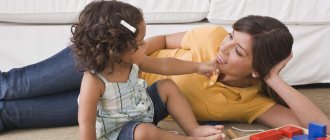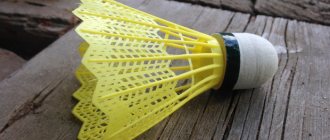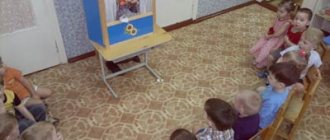MAGAZINE Preschooler.RF
Long-term project “Innovative technologies in the development of speech of children of senior preschool age”Project information card:
Full name of the project “Correct speech is the key to success”
Type, type of project - long-term, creative - educational.
Venue—MADOU Kindergarten No. 9 (building 2) Uchaly, Republic of Bashkortostan
Dates: September 2022. –March 2022
Project participants: students of preparatory group No. 9 (kor. 2), teachers, speech therapist, music director, parents of students.
Children age 6-7 years
Explanatory note:
This project is designed for children 6-7 years old. It is at this age that children become motivated and interested in expanding their vocabulary and learning to read and write, and there is a sharp jump in the ability to pronounce words clearly and correctly. Children take part in theatrical productions with pleasure and emotionally absorb works of fiction and poetry with great interest. This must be used to instill skills and knowledge in the field of comprehensive speech development. The project will be implemented in several directions: working with children, achieving the main goal and solving main problems; working with parents. Only with the help of parents can the maximum effect be achieved. The project involves the use of innovative forms and methods of presenting material to children, these are stories and practical exercises, video and photo materials, vocabulary games during classes, the use of demonstration material, didactic games, matinees, entertainment, individual work, educational games by Voskobovich “Larchik” , storytelling, “Fairy tales for the tongue” .
Rationale.
Currently, due to the widespread use of electronic media, a very young child is seated with a phone, tablet, laptop, etc. Hence, the problem of speech development in children is still relevant. Problems with clear pronunciation of words and sounds. Inability to retell text, describe objects, conduct dialogues, monologue speech, unwillingness to concentrate on the book.
And it is in older preschool age that these gaps should be filled by instilling the necessary skills and knowledge. You can often encounter parents’ indifference and lack of understanding of the importance of this issue. Ignoring this problem gives rise to a gradual decline in cognitive skills in the child. All this will affect the child’s arrival at school, on a mental and physical level. “Correct speech is the key to success” was developed.
This project includes an incomparable, versatile, educational effect. It is this, in combination with different types of activities, that ensures the formation of the full development of children of senior preschool age. It contributes to the development of their ability to organize their leisure time in an interesting and meaningful way; increases the motivation of the child and his parents to lead an interesting, educational lifestyle.
Approaches to project implementation:
- system-activity – development of a system of activities to develop knowledge and skills in environmental management among early preschoolers and their parents;
- culturological – organization of the behavior of children and their parents in nature based on the formation of their cultural relations to nature and the environment.
Goal: relying on new technologies, to create conditions for preserving and strengthening children’s interest in developing their speech. Expand and strengthen children’s storytelling skills, inventing a plot, and imagining. Develop the emotional sphere of children of senior preschool age.
Tasks:
Improve and enrich children's cognitive experience in speech development
Teach children knowledge and skills using new techniques and methods
Encourage children to speak clearly and correctly.
To educate and develop attention, independence, thinking, memory in children
Principles
- the principle of controllability and purposefulness - involves creating conditions for the formation of children's knowledge of speech development
- the principle of effectiveness – aimed at achieving intellectual and practical results.
Expected results: in speech development
- The ability to independently compare objects with each other, name several significant signs of similarity and difference.
- Independently compose a coherent story of at least 6-7 sentences.
- Write stories from personal experience
- Change words to form new ones
- Retell short stories
- Correctly use difficult forms of familiar words
- Use anonymous names in speech
In teaching literacy
- Determine the number of syllables in words
- Determine the number of sounds in words
- Determine the place of a given sound in a word
- Analyze the sound composition of a word
- Identify stressed syllables, stressed vowels
- Distinguish between consonants and vowels
- Distinguish between hard and soft sounds
- Make sentences of 2-3 words
Sound culture of speech
- Reinforce the correct pronunciation of sounds
- Pronounce sounds clearly and accurately with varying voice levels
- Differentiation of sounds in tongue twisters, in pure tongue twisters
Theatrical activities
- Emotional and aesthetic perception of works
- Introduction to fiction
- Introduction to folklore
Used Books:
- V. V. Gerbova “Speech development in kindergarten” Mosaic-City Moscow, 2014. -112 s.
- A.V. Aji “Notes of integrated classes in the preparatory group” Voronezh shopping center “teacher” , 2006 -333p.
- N.S. Golitsina “Summaries of complex thematic classes” -M. "Scriptorium" , 2013 -568 pp.
- L.V. Upravleeva “Preparation for school in kindergarten. Counting, reading, speaking, thinking" Yaroslavl. Development Academy, 2007-224
- N.N. Gladysheva, Yu.B. Sergeantov “Teacher’s work program” - Volgograd 2014. -445 s.
- T.S. Komarova, N.E. Veraksy, M.A. Vasilyeva “Complex classes” - Volgograd-2014. -415s.
- Children's reading book for children 6-7 years old.
- Internet resources “Voskobovich’s Manuals” , “Storytelling”
| Next > |
Speech development of preschool children through innovative and developmental technologies.
The goal is to increase the level of pedagogical competence in the use of interactive technologies.
“The origins of children’s abilities and gifts are at their fingertips.
The more confidence in the movements of a child’s hand, the more subtle the interaction between the hand and the tool, the more complex the movements, the brighter the creative element of the child’s mind. And the more skill in a child’s hand, the smarter the child...” V. A. Sukhomlinsky
Relevance – The problem of speech formation in preschool children is relevant today. Formation of speech in preschoolers is an important and difficult task. The successful solution of this problem is necessary both for preparing children for the upcoming school education, and for comfortable communication with others. However, the development of speech in children in the present tense is a pressing problem, which is due to the importance of coherent speech for preschoolers.
Traditional methods of teaching preschoolers recommend using a teacher's story sample as the main teaching technique. But experience shows that children reproduce the teacher’s story with minor changes, the stories are poor in expressive means, the vocabulary is small, and there are practically no simple common and complex sentences in the texts. But the main disadvantage is that the child does not construct the story himself, but only repeats what he heard. During one lesson, children have to listen to several monotonous stories of the same type. For children, this type of activity becomes boring and uninteresting, they begin to get distracted. It has been proven that the more active a child is, the more he is involved in activities that interest him, the better the result. The teacher needs to encourage children to engage in speech activity, and it is also important to stimulate speech activity not only in the process of free communication, but, above all, in speech therapy classes.
To achieve this goal, it is necessary to define the following tasks:
— study and analyze psychological, pedagogical and methodological literature on the problem of speech development in preschool children;
— use innovative and developmental technologies in work on speech development in preschoolers;
— check the feasibility and success of using innovative and developmental technologies in classes on speech development for preschoolers;
— interact with parents and teachers (parent meetings, seminars, consultations, booklets);
— create a subject-development environment for the use of innovative and developmental technologies (card indexes, didactic games);
-develop children’s speech using all groups of non-traditional methods in their work.
The modern subject-development environment also plays a major role in the development of children’s speech.
When creating a speech zone, we pay attention to games, manuals and materials. It is important that they are aimed at developing all aspects of speech: pronunciation, grammatical structure, vocabulary development, syllabic structure and coherent speech. To do this, we use: sets of didactic subject and plot pictures on basic lexical topics, sets of toys, printed didactic games.
Familiarization with fiction plays an important role in the development of speech. All groups have a book corner in which children's books, anthologies of works, pictures for composing stories, illustrations on topics of interest to children are stored. In younger groups, teachers make baby books. Children really like homemade books with stories and fairy tales.
Recently, the issue of using innovative technologies in preschool educational institutions has been increasingly raised, since the introduction of innovations into the work of an educational institution is the most important condition for improving and reforming the preschool education system. Innovative methods are introduced new methods and tools with increased efficiency, techniques that are the end result of the teacher’s intellectual activity.
The use of interactive pedagogical technologies in the educational process of preschool educational institutions, such as collaborative learning, project methodology, interactive interaction, and the use of new information technologies, help us implement a personality-oriented approach to children, ensuring individualization and differentiation of the pedagogical process, taking into account their abilities and level of development.
Today the focus is on the child, his personality, and his unique inner world. Therefore, we set ourselves the goal of choosing methods and forms of organizing the educational process that optimally correspond to the goal of personal development. Since a necessary condition for the development of a child’s personality, his consciousness and self-awareness is communication with adults and peers, which is associated with innovative technologies in organizing the process of children’s speech development, therefore this direction of the educational process of our preschool educational institution is a priority.
The task of teachers is to create conditions for the practical mastery of spoken language for each child, to choose such teaching methods and techniques that would allow each student to demonstrate their speech activity, their word creativity. The activities of the teaching staff should be aimed at developing communication skills in preschoolers, a culture of communication, the ability to briefly and clearly formulate thoughts, obtain information from various sources, and create a language environment that promotes the emergence of natural needs for communication.
Play is one of the best ways to develop children's speech and thinking. It gives the child pleasure and joy, and these feelings are the strongest means of stimulating the active perception of speech and generating independent speech activity. All organized games, including finger games, accompanied by speech, turn into original small performances. They captivate kids so much and bring them so many benefits!
The level of development of children's speech is directly dependent on the degree of formation of hand movements. If the development of finger movements corresponds to age, then the development of speech is also within normal limits, but if the development of fingers lags behind, the development of speech also lags behind, although general motor skills may be within normal limits and even higher. In addition, finger games give our children health, since this affects the skin of the hands, where there are many points associated with certain organs. Teacher Smirnova T.A. a card index of finger games has been developed, finger games are practiced in water, which, in turn, are part of hardening activities.
Lessons on a long-term plan for the development of speech on lexical topics using
Health saving technologies.
1. Technologies for preserving and stimulating health: Stretching, rhythmoplasty, dynamic pauses, active and sports games, relaxation, aesthetic technologies, finger exercises, eye exercises, breathing exercises, invigorating exercises, corrective exercises, orthopedic exercises.
2. Technologies for teaching a healthy lifestyle: Physical education, problem-based games (game training and game therapy), communicative games, classes from the “Health” series, self-massage, acupressure self-massage, sud-jok therapy.
3. Corrective technologies: Art therapy, musical influence technologies, fairy tale therapy, color influence technologies, behavior correction technologies, psycho-gymnastics.
The use of mnemonic diagrams helps the child enrich a coherent statement.
Mnemonics - translated from Greek - “the art of memorization.” This is a system of methods and techniques that ensure successful memorization, preservation and reproduction of information, knowledge about the characteristics of natural objects, the world around us, effective memorization of the structure of a story, and, of course, the development of speech.
The essence of mnemonic schemes is as follows: for each word or small phrase, a picture (image) is created; thus, the entire text is sketched schematically. Looking at these diagrams - drawings, the child easily reproduces textual information.
To help children master coherent speech and facilitate this process, mnemonics are used.
Mnemonic tables - diagrams serve as didactic material in the development of coherent speech in children. They are used: to enrich vocabulary, when learning to compose stories, when retelling fiction, when guessing and making riddles, when memorizing poetry.
For children of primary and secondary preschool age, it is necessary to provide colored mnemonic tables. For older children, it is advisable to draw diagrams in one color.
Like any work, mnemonics is built from simple to complex. It is necessary to start working with the simplest mnemonic squares, sequentially move on to mnemonic tracks, and later to mnemonic tables, because children retain individual images in their memory: a Christmas tree is green, a berry is red. Later - complicate it or replace it with another screensaver - depict the character in graphic form.
Mnemonic tables are especially effective when learning poems: for each word or small phrase a picture (image) is created; Thus, the entire poem is sketched schematically. After this, the child reproduces the entire poem from memory, using a graphic image. At the initial stage, the adult offers a ready-made plan - a diagram, and as the child learns, he is also actively involved in the process of creating his own diagram.
It is better to start working with mnemonic tables from the middle group. Although already at a young age we use the simplest schemes for dressing, washing, building a pyramid, etc.
Preschool childhood is the age when the ability to creatively solve problems that arise in a given situation in a child’s life (creativity) appears. Skillful use of TRIZ techniques and methods (the theory of inventive problem solving) successfully helps to develop inventive ingenuity, creative imagination, and coherent speech in preschoolers.
TRIZ for preschoolers is a system of collective games and activities designed not to change the main program, but to maximize its effectiveness.
Work on the TRIZ system with preschool children should be carried out gradually. To solve TRIZ problems, the following stages of work can be distinguished:
1. Teach the child to find and distinguish between contradictions that surround him everywhere. (What do a bird and a butterfly have in common? What do a bus and a house have in common?), etc.
2. Teach children to fantasize and invent. (For example, come up with a new house that is beautiful and unusual.)
3. Solve fairy tale problems and invent different fairy tales using special TRIZ methods. (For example, “You find yourself on a desert island, what could happen to you?”)
Having studied theoretical materials and become acquainted with the methods of TRIZ technology, I selected exactly those methods that solve the problems of forming monologue speech and began to create conditions for work.
TRIZ elements can be used in all educational areas, but more often in such areas as cognition, communication, artistic creativity, reading fiction, in gaming activities, as well as in routine moments. Thus, each type of activity contributes to the development of speech and creative potential of preschool children.
From all of the above, the conclusion follows: the development of preschool education and its transition to a new qualitative level cannot be carried out without the use of innovative technologies in working with preschool children.





